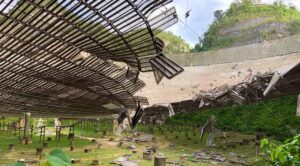NASA weighing options for future planetary radar capabilities after Arecibo
By Jeff Foust

WASHINGTON — With the Arecibo radio telescope set to be decommissioned, NASA is beginning to consider options for future planetary radar capabilities, including potential cooperation with the U.S. Space Force.
NASA has used the 305-meter-diameter radio telescope at Arecibo Observatory in Puerto Rico for years as a radar, particularly for studies of near Earth asteroids. While the radar isn’t used to discover asteroids, it can refine their orbits and help characterize them.
However, the National Science Foundation (NSF), which owns the observatory, announced Nov. 19 it will decommission the telescope after engineering analyses showed the telescope was at risk of collapse. Two cables that help support an instrument platform suspended over the dish snapped, one in August and the other Nov. 6, and engineering studies concluded the risk of an uncontrolled collapse is too great to allow crews to repair the damage.
“This is a hard thing to have to take,” Lindley Johnson, director of NASA’s Planetary Defense Coordination Office, said at a Nov. 30 meeting of the agency’s Planetary Science Advisory Committee. His office funds the planetary radar work at Arecibo.
The closure of Arecibo, he said, will have “a slight negative impact” on NASA’s planetary defense work. NASA has another radar system at the Goldstone Observatory in California that can also be used for observing near Earth asteroids and other objects. The Goldstone radar is back in operation after recently installing a new klystron.
The Goldstone radar has some advantages over Arecibo, including being able to see more of the sky and finer resolution. However, Arecibo’s more powerful radar has a greater range, allowing it to observe more distant objects.
Another disadvantage for Goldstone is that it is located near restricted military airspace, which requires coordination for radar observations that can make it difficult to use for time-sensitive studies. Johnson said that process has improved somewhat.
Johnson argued that the closure of Arecibo presents an opportunity to examine the future of planetary radar systems. “It’s really time to be looking at the next generation of planetary radar capabilities,” he said. That’s likely to use arrays of smaller dishes rather than one monolithic dish, like Arecibo.
Old facilities, he added, are “high maintenance” and difficult to keep operate. “Technology has moved on from 30 years ago,” when Arecibo first got planetary radar capabilities, he said. “We need to take advantage of the new technologies.”
Any future planetary radar system would likely be done in partnership with other organizations. With few exceptions, notably the Infrared Telescope Facility observatory in Hawaii, NASA does not operate ground-based telescopes, focusing instead on space-based observatories.
The NSF has not discussed what plans, if any, it has for a successor to Arecibo, but Johnson suggested one possibility for NASA might be cooperation with the military. “We do definitely have an opportunity and an interest in partnering with the U.S. Space Force on a more capable radar system,” he said.
The Space Force’s interest in such a radar, he said, would be to track objects in cislunar space, something that would require a radar more powerful than existing ones that are limited largely to tracking objects in low Earth orbit. The Pentagon has shown growing interest in monitoring objects in the region between the Earth and the moon, including an experimental spacecraft mission called the Cislunar Highway Patrol System, or CHIPS, under development by the Air Force Research Laboratory.
“Those are the kinds of things that are being talked about,” Johnson said. “What agencies can NASA partner with for a future planetary radar capability?”
Some members of the advisory committee, though, weren’t ready to give up on Arecibo, asking NASA officials if all the options for repairing the radio telescope there had been exhausted. “I think it would be good to have some additional study before final decisions are made, but the NSF will have the lead on it,” Johnson said.
“Arecibo is an NSF facility, and the responsibilities for ground-based observatories lie with NSF. It’s not in NASA’s purview,” said Lori Glaze, director of NASA’s planetary science division.
She emphasized the NSF made the decision to decommission the Arecibo radio telescope based on safety. “This is NSF’s decision to make,” she said, “and we’re supporting them in their decision to put safety first.”
December 1, 2020 at 05:57PM
via SpaceNews read more...

Post a Comment